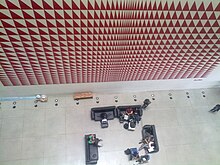Luis Sacilotto

Luis Sacilotto (born April 22, 1924 in Santo André near São Paulo; † February 9, 2003 in São Bernardo do Campo , Brazil ) was a Brazilian painter and sculptor .
Life
Luiz Sacilotto was born the son of Italian immigrants Antonio Sacilotto and Thereza Cancellier Sacilotto. Sacilotto studied painting at the Escola Profissional Masculina do Brás from 1938 and 1943 and made his diploma (MA) at the Escuela Técnica Getúlio Vargas . From 1944 and 1946 he worked as a draftsman at Hollerith do Brasil and in 1946 switched to the Jakob Ruchti architectural office as a designer . In the same year he took part for the first time in an exhibition that took place in the Prestes Maia Gallery in São Paulo. Here he met his colleagues Waldemar Cordeiro (1925–1973) and Lothar Charoux (1912–1987), with whom he had a long friendship.
The artist's early work was shaped by cubist formal elements and by the painting of Piet Mondrian . Since the early 1950s, Sacilotto's painting has been influenced by the concrete art of the Swiss painter, sculptor and architect Max Bill , who exhibited in the Museo de Sao Paulo in 1950 . The exhibition made a lasting impression on a young generation of Brazilian artists who wanted to break away from abstract expressive painting. In 1952 Sacilotto and his colleagues Waldemar Cordeiro, Leopoldo Haar (1910–1954), Lothar Charoux and others signed a manifesto that led to the founding of Grupo Ruptura in São Paulo. The group shaped the discussion about non-figurative painting in Brazil and had a decisive influence on the introduction of international concrete art in Brazil.
Luis Sacilotto " ... explored optical phenomena or the relationship between figure and background, surface and space, positive and negative as well as the development of line and color [...] " with painting and sculpture . In his small steel sculpture Concreção 8750 (Escultura Negra) (1987), shown in the Aue pavilion at documenta 12 in Kassel (1987), Sacilotto transferred his dynamic stripes into the third dimension. The geometric sculpture hanging freely in the room played “ ... optically with the relationship between real and imagined space [...]. A rhythm of regular intervals of colors and lines almost seems to develop… ”. The rhythm of the form was heightened by the creation of moving shadows on the wall.
Sacilotto was considered a pioneer of Op Art in his country and was represented in important exhibitions such as the Biennale of São Paulo and the Guggenheim show “Brazil”.
Exhibitions
- 2007: documenta 12 , Kassel
- 2009: Dimensions of constructive art in Brazil , Haus Konstruktiv , Zurich
Works in public collections
- Museu de Arte Moderna de São Paulo
- Museu de Arte Moderna do Rio de Janeiro
- Museu de Arte Contemporânea da Universidade de São Paulo
- Pinacoteca do Estado de São Paulo
literature
- David Aradeon: Luis Sacilotto . In: documenta 12, catalog . Taschen, Cologne 2007, ISBN 978-3-8228-1677-6 , p. 56 ff.
- Fernando Cocchiarale, Ana Bella Geiger: Abstracionismo - geométrico e informal, a vanguarda brasileira nos anos cinquenta . Funarte, Rio de Janeiro 1987, ISBN 85-246-0033-0 .
Web links
- Luis Sacilotto website (English, Brazilian Portuguese)
- Luiz Sacilotto . In: Enciclopédia Itaú Cultural . (Brazilian Portuguese, org.br [accessed May 3, 2018]).
- Luis Sacilotto, Escultura Negra, sculpture 1959. In: documenta.de. documenta 12, 2007, archived from the original ; accessed on May 3, 2018 .
Individual evidence
- ^ A b Luis Sacilotto, Escultura Negra, sculpture 1959. In: documenta.de. documenta 12, 2007, archived from the original ; accessed on May 3, 2018 .
- ↑ Format 37 × 51 × 20 cm, on loan from The Fontanals Cisno Collection , Miami
| personal data | |
|---|---|
| SURNAME | Sacilotto, Luis |
| ALTERNATIVE NAMES | Sacilotto, Luiz |
| BRIEF DESCRIPTION | Brazilian painter and sculptor |
| DATE OF BIRTH | April 22, 1924 |
| PLACE OF BIRTH | Santo André near São Paulo |
| DATE OF DEATH | February 9, 2003 |
| Place of death | Sao Bernardo do Campo , Brazil |